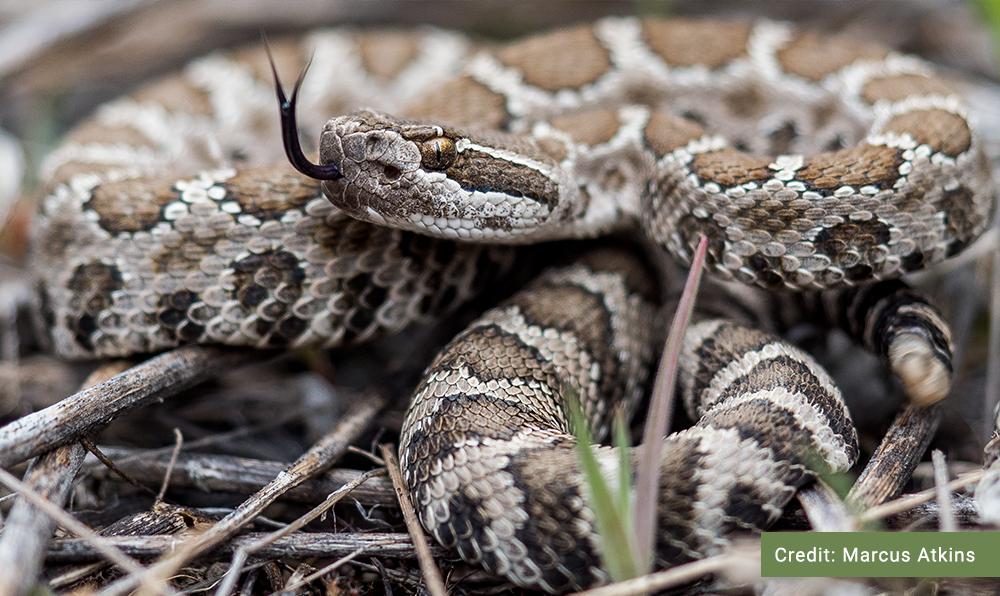Rattlesnake Awareness
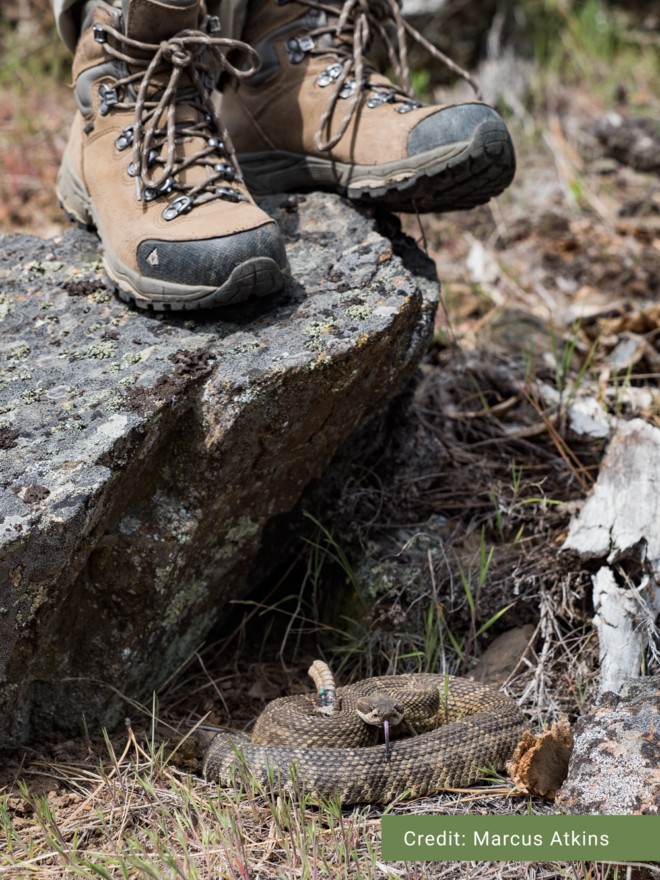
Here are some tips to stay safe in rattlesnake habitat:
- Keep your hands and feet where you can see them. Avoid stepping close to logs, shrubs and boulders where snakes may be hiding.
- Wear ankle-high boots and long loose pants while walking in rattlesnake habitat.
- If you must walk through tall grass, carry a long walking stick to disturb the grass in front of you or to tap rocks and logs. This will warn snakes that you are nearby.
- Walk with a partner, this is good practice especially in areas with high wildlife activity.
- Teach children to respect snakes and to not pick them up. This will help prevent snake bites.
- Never touch a Rattlesnake even if it appears to be dead. The biting reflex can remain intact even after a snake is dead.
- Stay on trails and keep your dog on leash.
- If you see or hear a snake, first stop and look all around you to check for other snakes nearby, then carefully move at least 5 meters away from the snake.
Stephanie Winton (TRU), Staying Safe in Snake Country 2018
Rattlesnake safety, WildsafeBC, 2019

Adult Western Rattlesnake
rattlesnake rattles
What do you do if you meet a rattlesnake?
If you encounter a rattlesnake or any snake, remain calm. Rattlesnakes are more afraid of you than you are of them and will only strike as a last resort. Here are a few tips to help you during a snake encounter:
- The first thing you should do is STOP. This is to ensure you don’t accidentally step on the snake.
- Locate the snake.
- Wait for the snake to move away from you.
- If the snake does not move, move directly away from the snake and give it lots of space.
If you like to admire snakes or take photographs, be sure to do this at a distance. Having binoculars or a camera with a zoom lens can help you remain a safe distance from the animal. Always leave snakes alone and try to disturb them as little as possible. Even if you are certain you are dealing with a non-venomous snake like a gartersnake, it is best to not handle it and leave it be. Remember that killing, capturing and harming snakes is illegal under the British Columbia Wildlife Act.
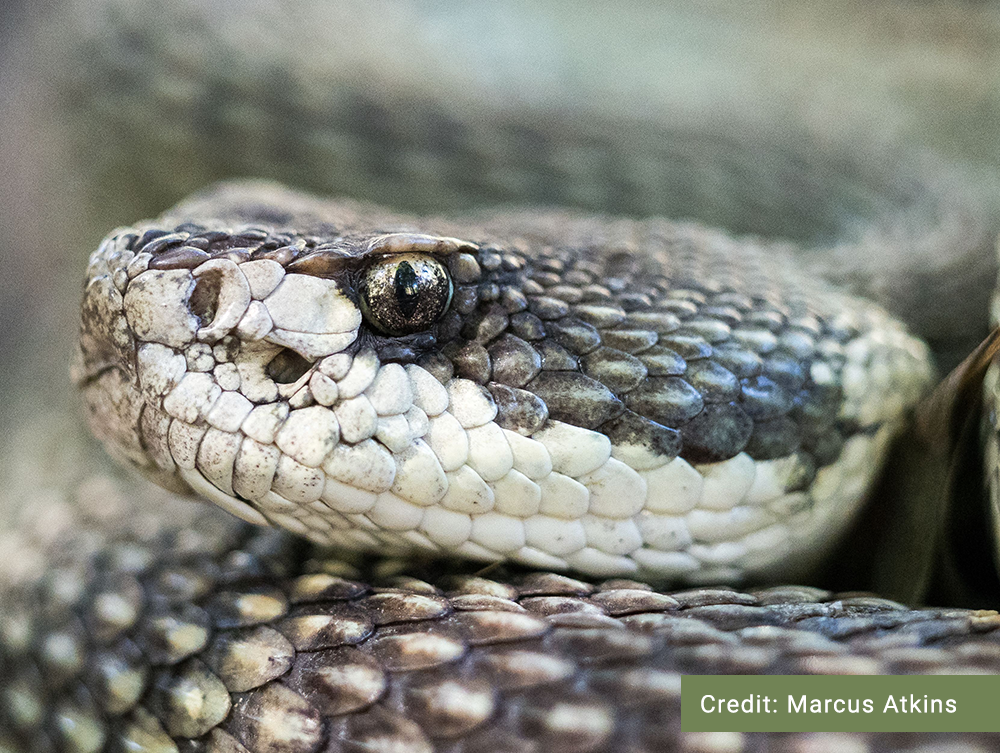
What do you do if you meet a rattlesnake?
Reactions to snake bites vary from person to person. It is best to always seek medical attention as soon as possible. Rattlesnake bites often occur when people handle juvenile rattlesnakes mistaking them for juvenile Gopher snakes. It is good practice to always respect any snake you encounter, give it space and avoid handling it.
If your dog has been bitten by a rattlesnake, call your vet immediately, so they can prepare for your dog or direct you to another clinic. Not all rattlesnake bites require anti-venom, your vet will assess your dog and determine if it is necessary. A dog’s reaction to a rattlesnake bite can vary so it is best to always take them to a vet to ensure their safety. Always keep your dog on leash while recreating in rattlesnake country to avoid negative encounters and bites.
ALWAYS
- Locate the snake (and potentially others) and move at least five meters away from it.
- Remove restricting clothing immediately (i.e. watches, rings, tight clothing, shoes).
- Carefully get the victim to the hospital. Call 9-1-1 as soon as possible, so the hospital can prepare for treatment of a rattlesnake bite. If you are alone: remain calm, avoid strenuous activity, call 9-1-1 and try to find help.
- Monitor the swelling around the bite. Every 15-20 minutes circle the reddened/swollen area and write the time beside the circle.
Never
- Never apply a tourniquet. It can cause more harm to the victim.
- Never suck out the venom, cut the wound or use a “snake bite kit”.
- The victim should never drive themselves to the hospital, if you are alone call 9-1-1 and be transported via ambulance.
- Never bring the snake that bit you to the hospital.
How can you tell the difference between a rattlesnake and a gopher snake?
To the novice eye it can be quite challenging to determine the difference between a rattlesnake and a gopher snake. Below are some tips to help you determine which snake species you have found. Rattlesnakes don’t always have intact rattles (and babies have buttons) so it is best to not rely on this feature to identify them, instead, look for their triangular head and blotched pattern on their body. Gophersnakes have a narrow head and thick neck, a pointy tail with no ratttle, and rectangular blotches on their body. Gophersnakes are also good at mimicking rattlesnakes! When threatened, they will hiss, strike, and vibrate their tail to mimic a rattle! See the video below for an example.
*Remember…before identifying a snake, always keep your distance, take a photograph from afar, or use binoculars to help you get a closer look.
Great Basin Gophersnake
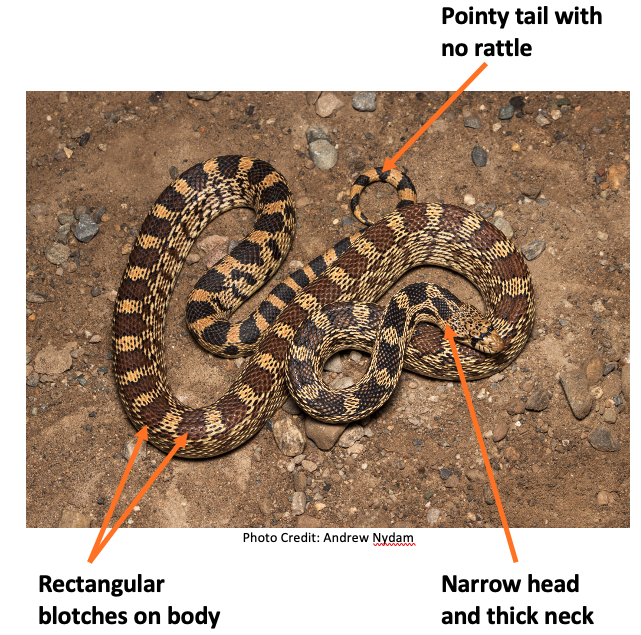
Western Rattlesnake

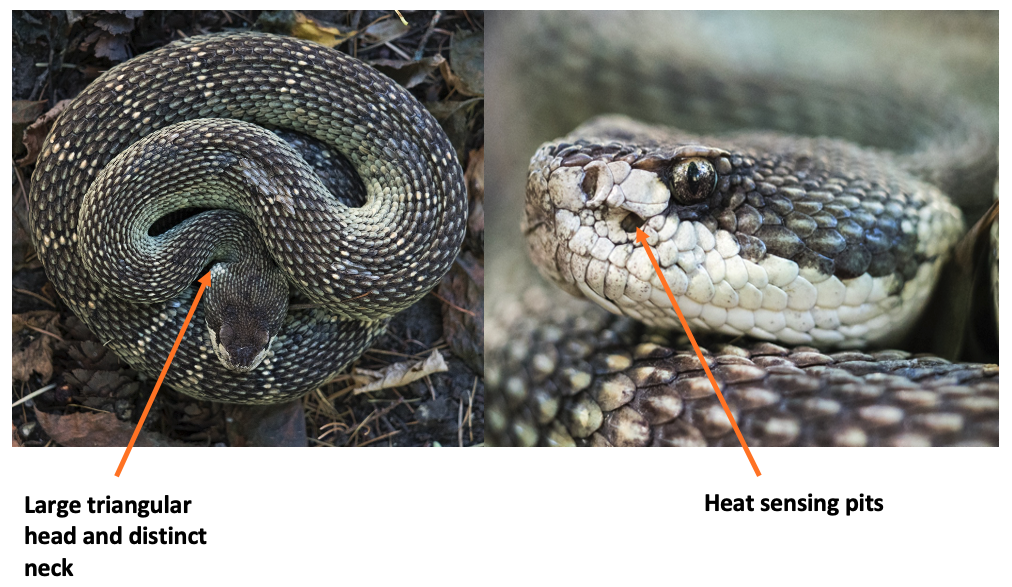
Neonate Snake Identification
Did you know newborn snakes can look very different from adults of the same species? Especially in the southern interior of British Columbia, young snakes of many species can appear similar. Here are some tips to help tell these babies apart!
Click below for some tips on how to tell these babies apart:
Neonate Western Rattlesnakes
Neonate (newborn) Western Rattlesnakes look like small versions of adults for the most part, but they lack a rattle. This means that they are not able to provide an audible warning signal like adult rattlesnakes can. Instead, newborn snakes will have a single modified scale at the tip of their tail called a button. Once the snake sheds, the button will become “loose” and be able to make a quiet buzzing sound, and eventually be accompanied by more segments to become the rattle. Looking for a button is the best way to tell if the baby snake you’re seeing is a rattlesnake.
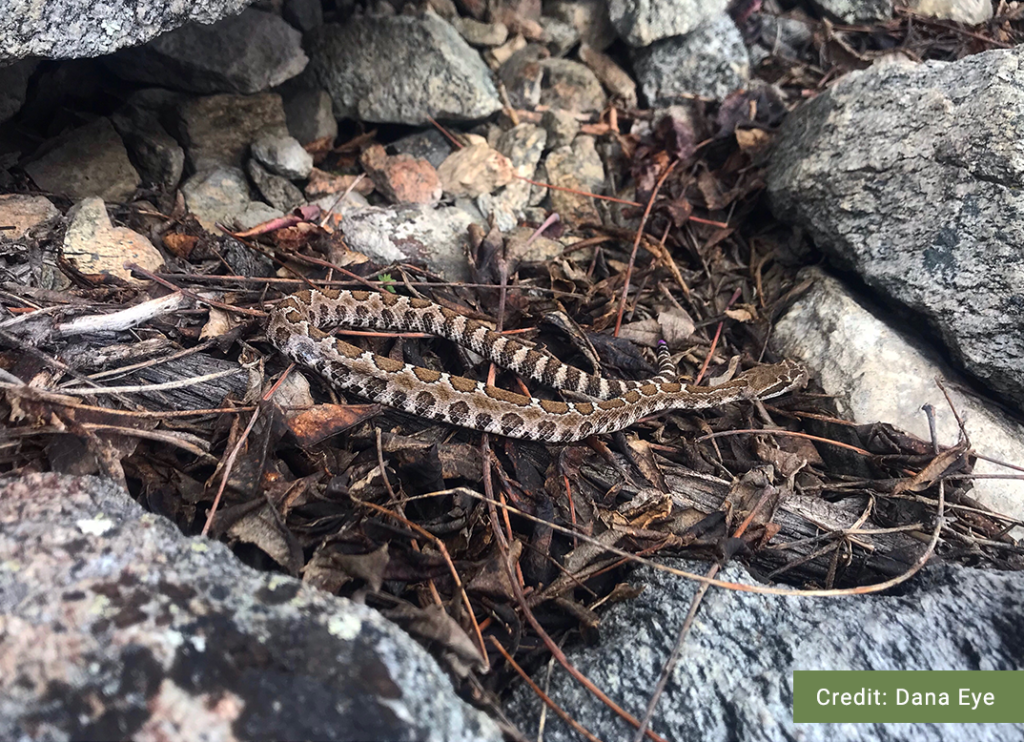
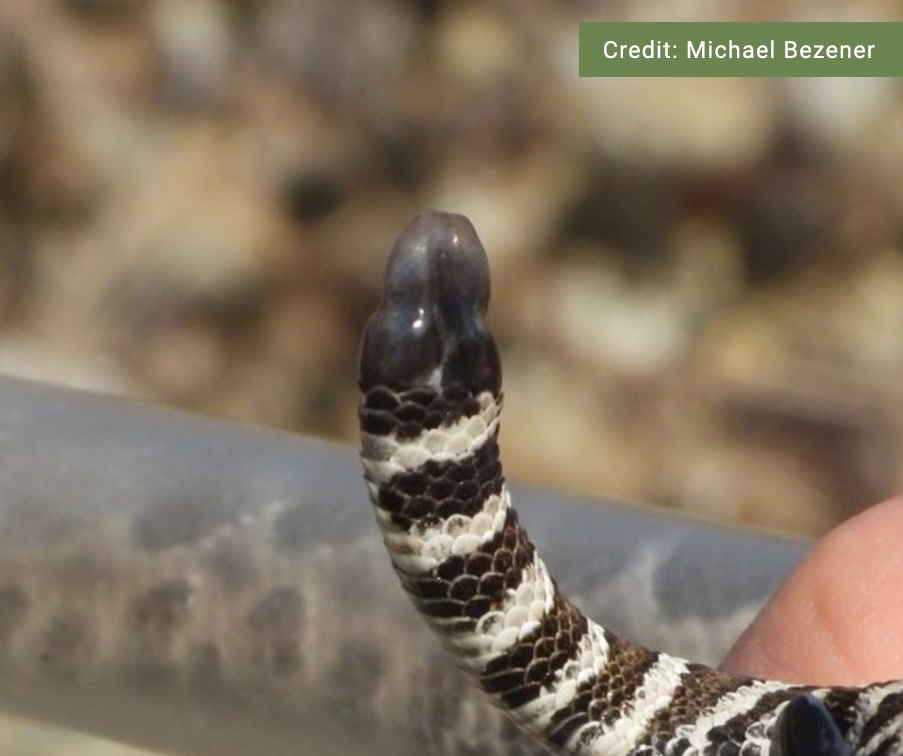
Newborn rattlesnakes have the same colouration and patterning as adults: dark blotches surrounded by white “halos” running down their backs that transition to rings at the tail, contrasted on a tan, olive, or dark green background. However, colouration tends to be brighter in younger snakes and becomes dull and faded as individuals age. Babies also have triangular-shaped heads, vertical pupils, and heat-sensing pits in their cheeks just like adults do!
Neonate Great Basin Gophersnake
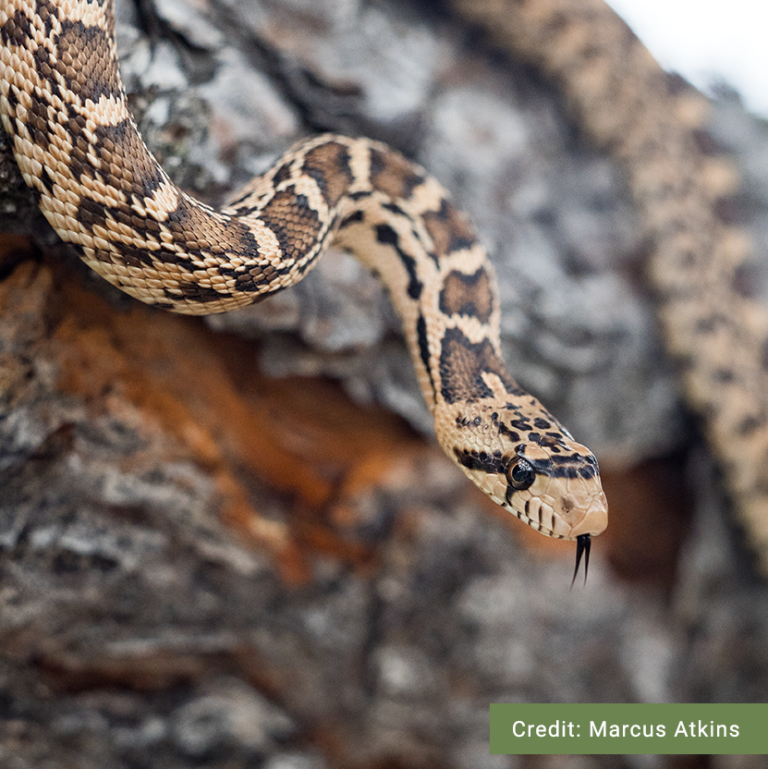
Neonate Great Basin Gophersnakes look like small versions of the adults. They have black or dark reddish-brown rectangular blotches down their back, contrasted on a creamy yellow background. They also have a dark mask running from the corners of their mouth and around each eye.
Neonate Yellow-bellied Racer
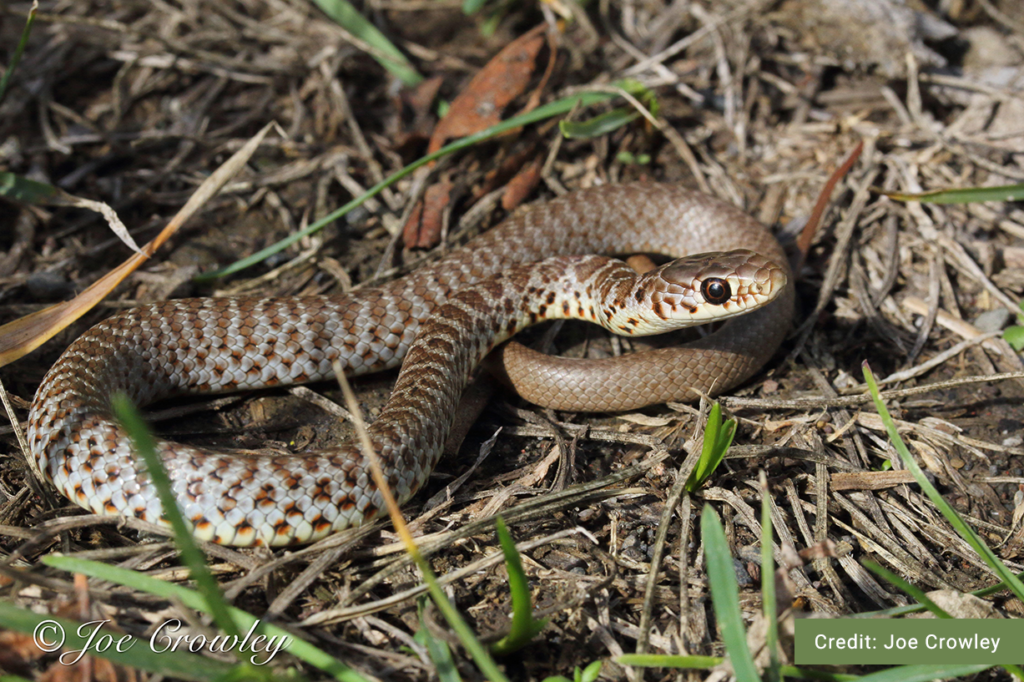
Neonate Yellow-bellied Racers have very different colouration than adults do. They are light brown or tan with dark patterning that helps camouflage them from predators while they are young. You can distinguish them from other newborn snakes in the area by their large, round eye, and less “structured” pattern that looks more like splotches and speckles, compared to a rattlesnake’s round patterning or a gophersnake’s rectangular patterning.
Desert Nightsnakes
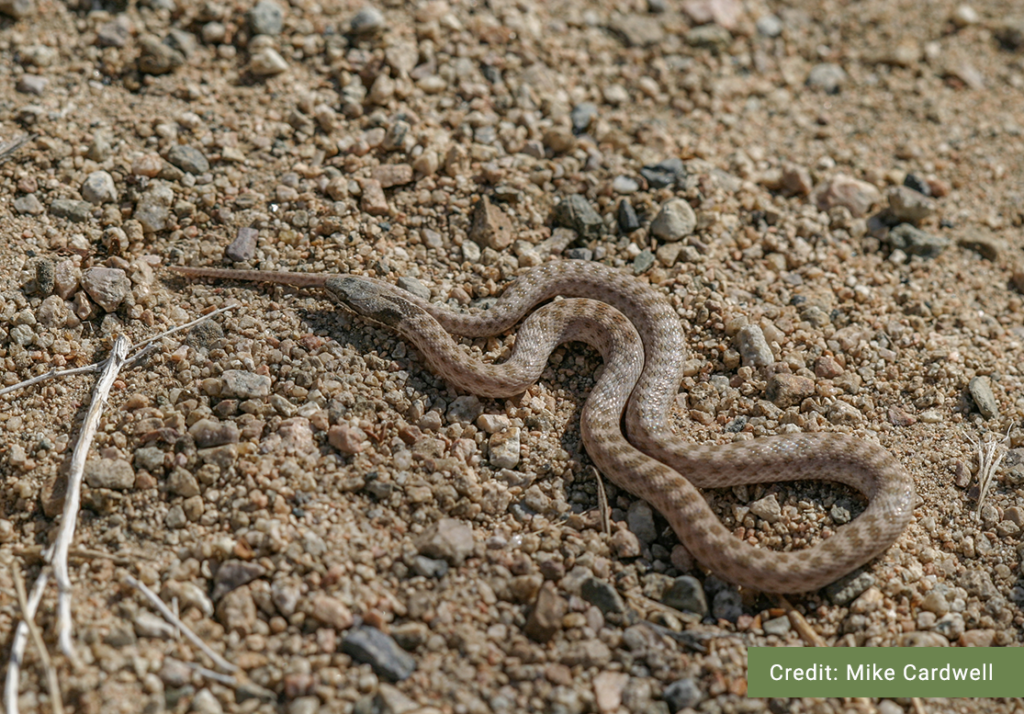
Since Desert Nightsnakes are a quite small, even an adult Nightsnake could be confused with newborns of another species. Their colouration consists of a tan, grey, or light brown background with dark brown, slightly square-shaped blotching. Although this colouration is similar to the other snake species, Nightsnakes can be distinguished by a black eye ‘mask’ that runs through each eye and connects to a dark ‘collar’ around the neck at the base of the head.
Western Terrestrial Gartersnakes
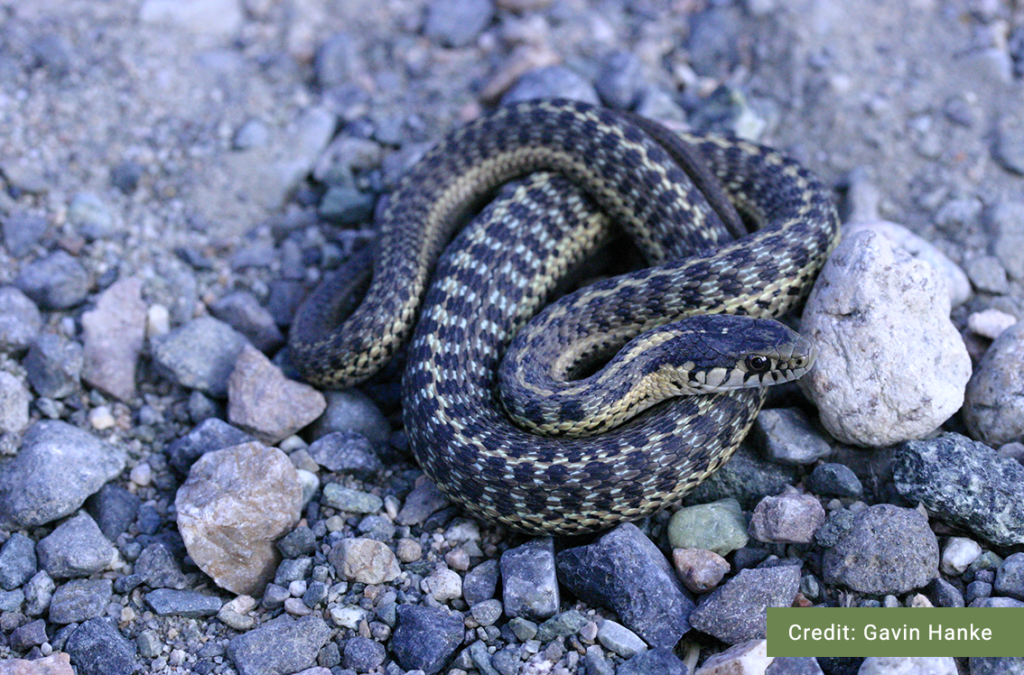
Western Terrestrial Gartersnakes look the same at all stages of their lives. They can be similar colours to the other snake species mentioned above: dull brown, beige, or olive, with darker checkering. However, Western Terrestrial Gartersnakes have yellow dorsal and lateral stripes, which the other species lack.
Common Gartersnakes
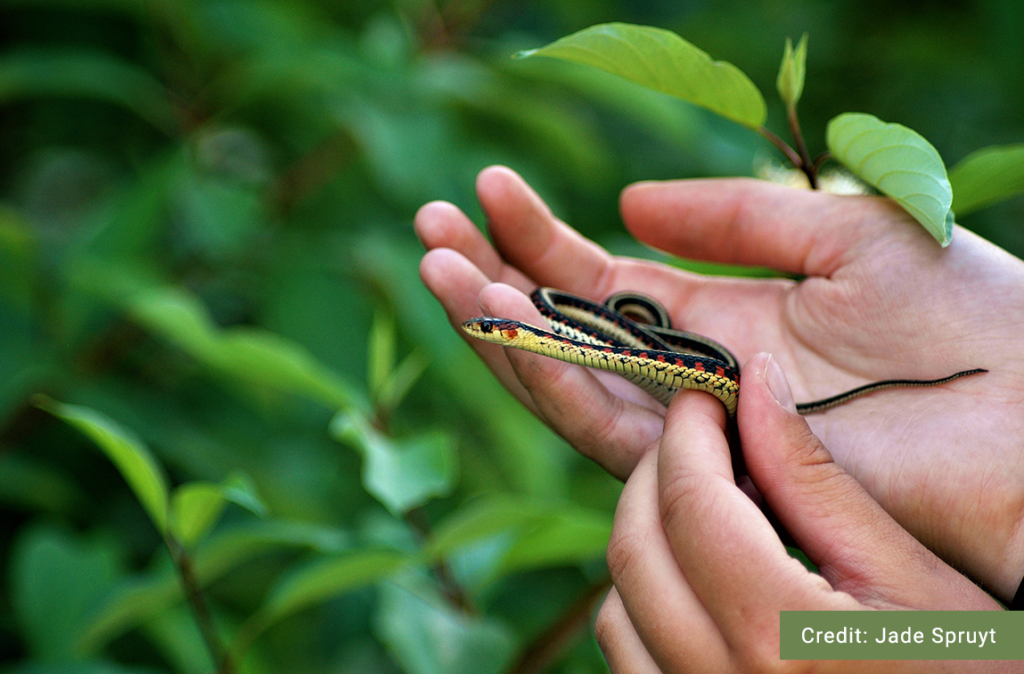
Common Gartersnakes also look the same throughout their entire lives, but their colouration is quite different from the other snake species mentioned here. They are black with bright yellow dorsal and lateral stripes and red barring along the sides.
Northwestern Gartersnakes
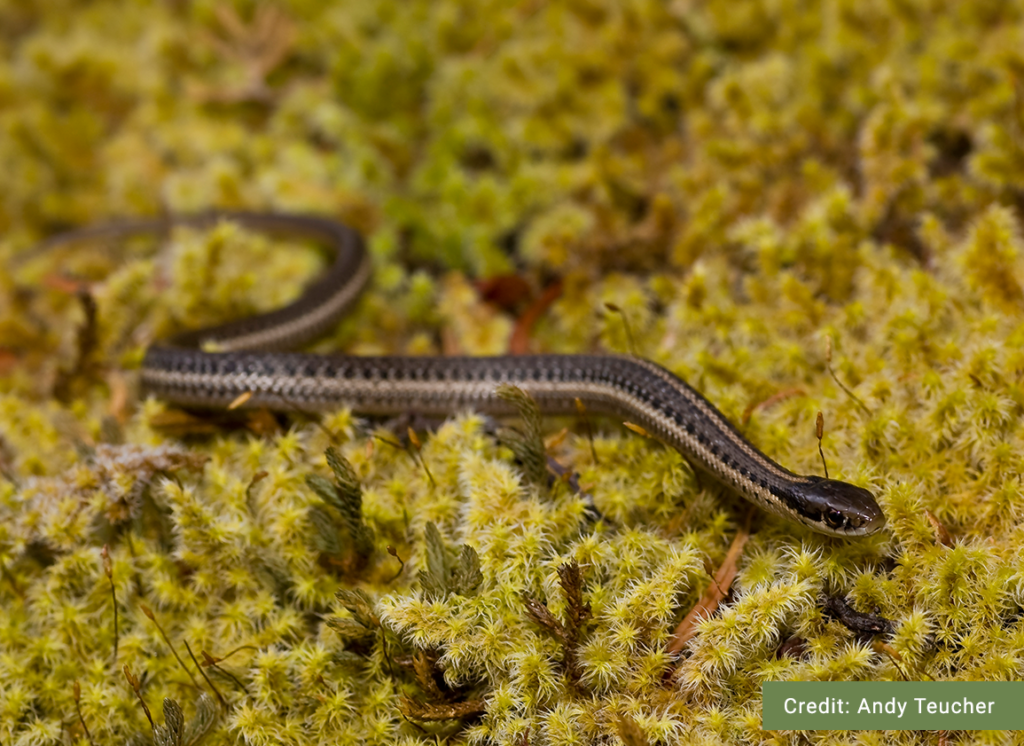
Across all ages the colour of Northwestern Gartersnakes varies more than any other snake species in British Columbia, but they are typically dull brown-grey to olive, often with faint checkering on the dorsal surface and a dorsal stripe. However, the colour of the dorsal stripe is extremely variable, and is sometimes lacking altogether.
Juvenile Rubber Boas
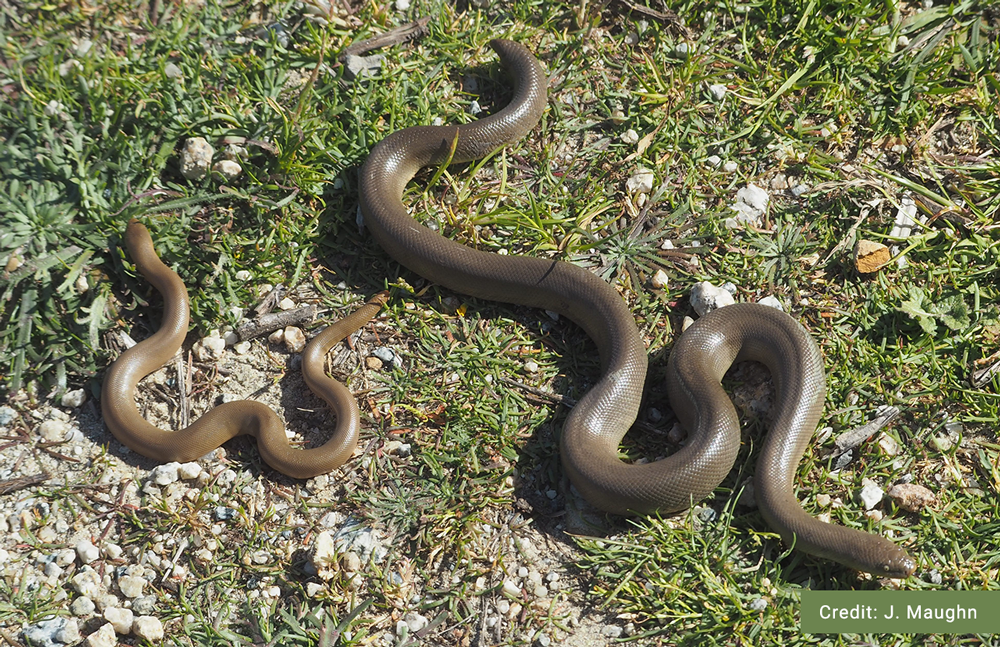
Juvenile Rubber Boas are more pink/orange in colour than adults, which are typically dark olive green or brown with pale orange-yellow bellies.
Juvenile Common Sharp-tailed Snakes
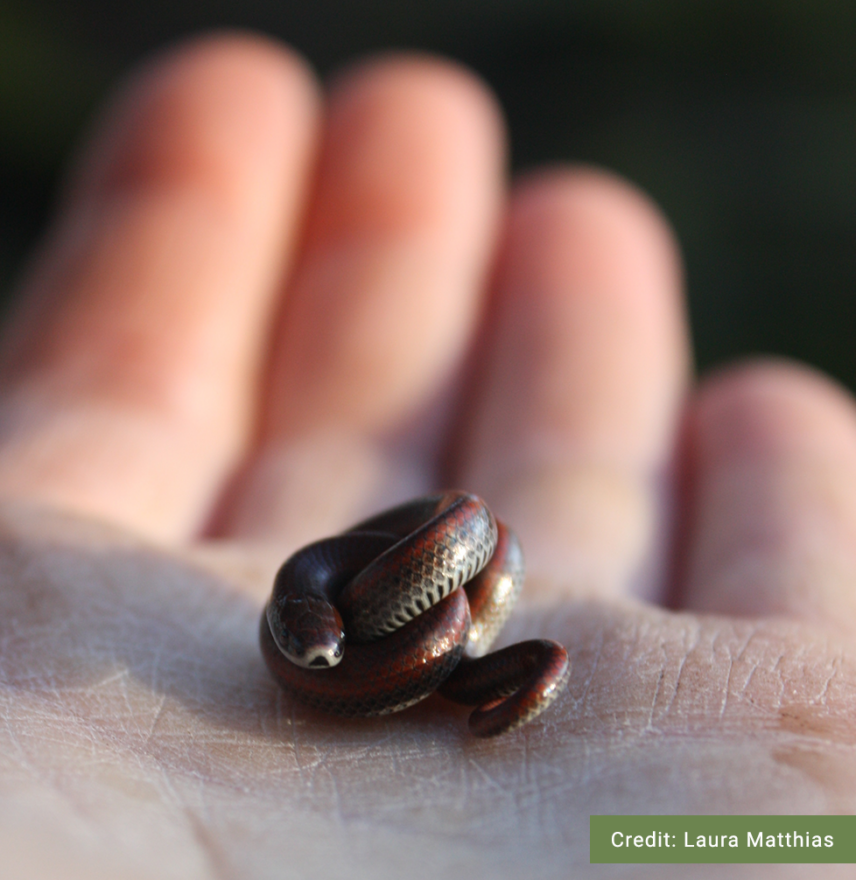
Juvenile Common Sharp-tailed Snakes are usually brighter in colour and may be more vibrant orange or red than their adult counterparts, which are grey, yellow-brown, or darker red.
Common Questions
Does a rattle tell you how old a rattlesnake is?
No. Rattles are made of segments of tissue that are loosely connected together. When a rattlesnake is born, it has only a tiny nub of horny tissue at the tip of its tail (called a button). The true rattle is formed with the first shed, when a segment is added to the end of the button. Each time a rattlesnake sheds, a new segment is added to the rattle.
In a single year, a rattlesnake may shed many times, or it may not shed at all. Just like you, a snake’s growth depends on its environment and how much it has to eat. In fact, the rattle will experience wear and tear over the snake’s lifetime, therefore the rattle may be broken, or segments may be lost. So, the rattle is not a good indicator of age, or even of how many times a snake has shed its skin. It is also important to not always rely on the rattle as a key identifying feature of a rattlesnake, instead look for a triangular head and round shaped patterning on the body.
Note: The photos below are taken by rattlesnake researchers in a safe manner. Never try to handle rattlesnakes or take photos this closely.
In a single year, a rattlesnake may shed many times, or it may not shed at all. Just like you, a snake’s growth depends on its environment and how much it has to eat. In fact, the rattle will experience wear and tear over the snake’s lifetime, therefore the rattle may be broken, or segments may be lost. So, the rattle is not a good indicator of age, or even of how many times a snake has shed its skin. It is also important to not always rely on the rattle as a key identifying feature of a rattlesnake, instead look for a triangular head and round shaped patterning on the body.
Note: The photos below are taken by rattlesnake researchers in a safe manner. Never try to handle rattlesnakes or take photos this closely.
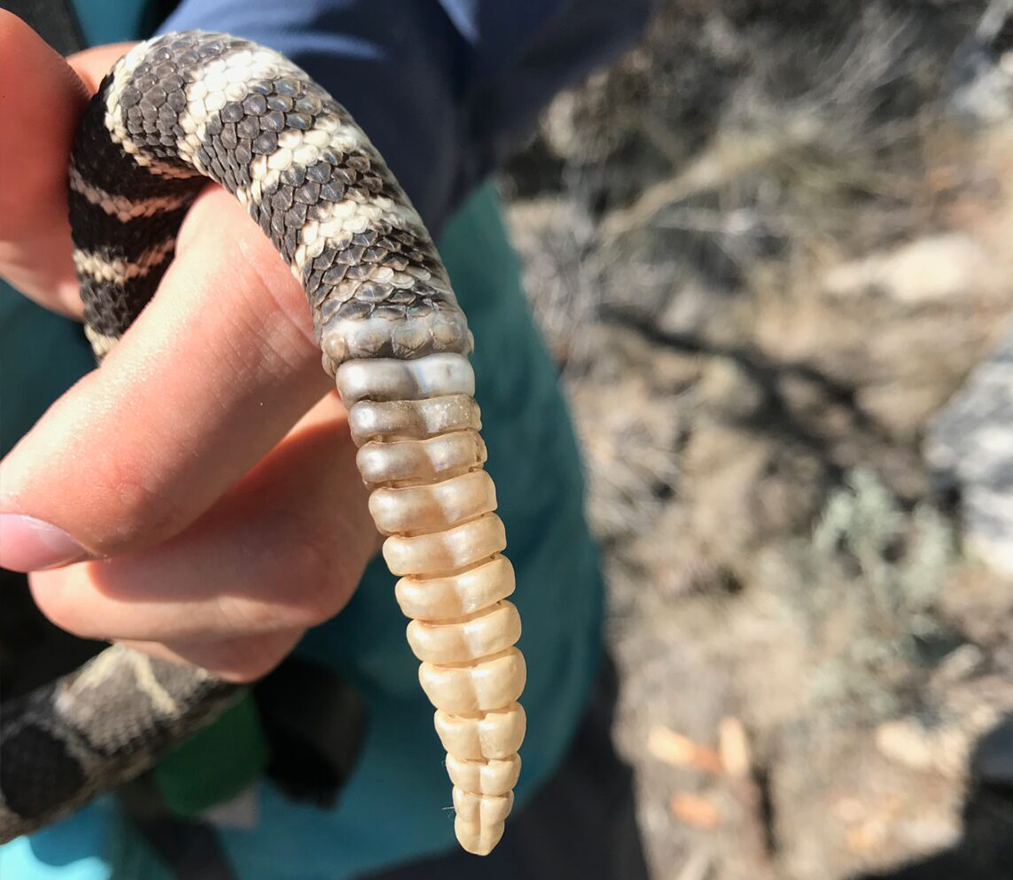
Adult Western Rattlesnake rattle. The white segment at base indicates this snake is about to shed its skin.
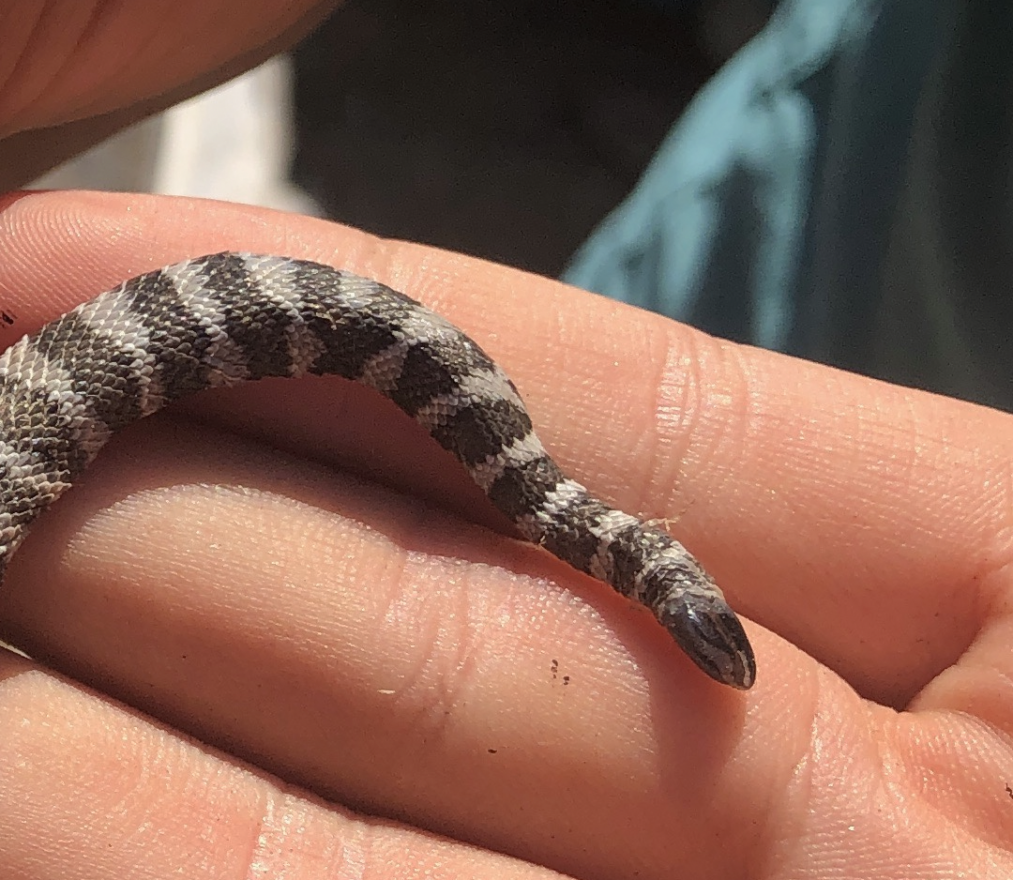
Recently born neonate (baby) Western Rattlesnake tail with a button.
Are baby rattlesnakes more dangerous than adults?
Often people think young rattlesnakes are more dangerous than adult rattlesnakes and this is not necessarily true. When rattlesnakes are born, they have a button at the end of their tail that cannot make a sound until the rattlesnake sheds its skin. Therefore, during this life stage, rattlesnakes are unable to use their rattles as a warning signal and people may unknowingly step on them and get bitten. Additionally, people often pick up young rattlesnakes mistaking them for gophersnakes and ultimately get bitten in the process. Baby rattlesnakes do not have more potent venom than an adult, and in fact, the larger a rattlesnake is, the more venom it can store in the sacs in its head. Therefore, a bite from an adult rattlesnake can be much more fatal for this reason. Ultimately, if you are bitten by a rattlesnake, whether it is small or large, always seek medical attention as soon as possible.
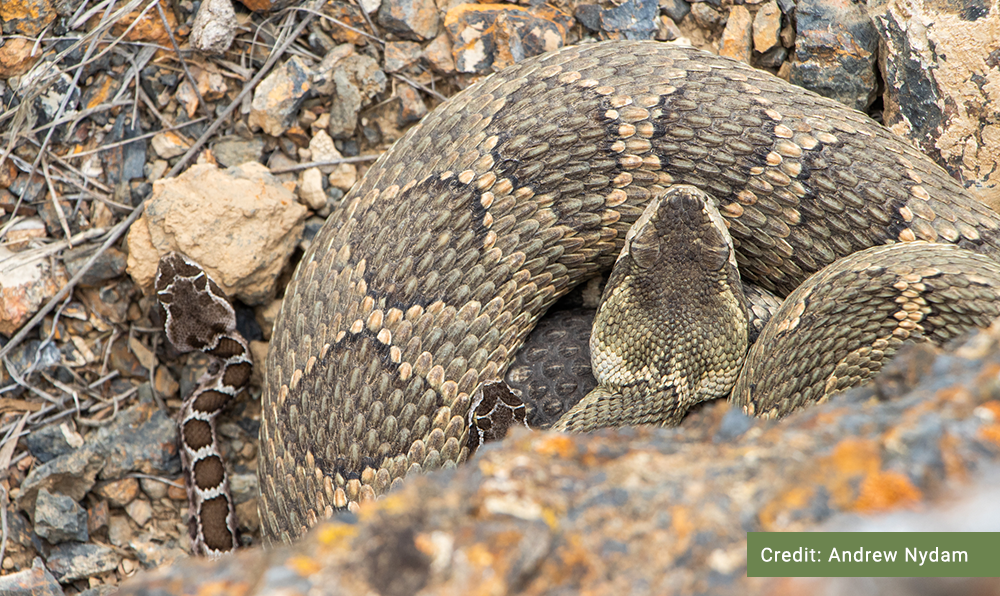
Neonate Western Rattlesnakes next to an adult
Do rattlesnakes replace their fangs?
Yes! Rattlesnakes are constantly forming new fangs behind the fangs currently in use. This is an important adaptation because the fangs are a vital tool enabling rattlesnakes to hunt and secure their prey. If the current fangs are broken, it is only a matter of time before a new pair is ready and in place in the upper jaw.
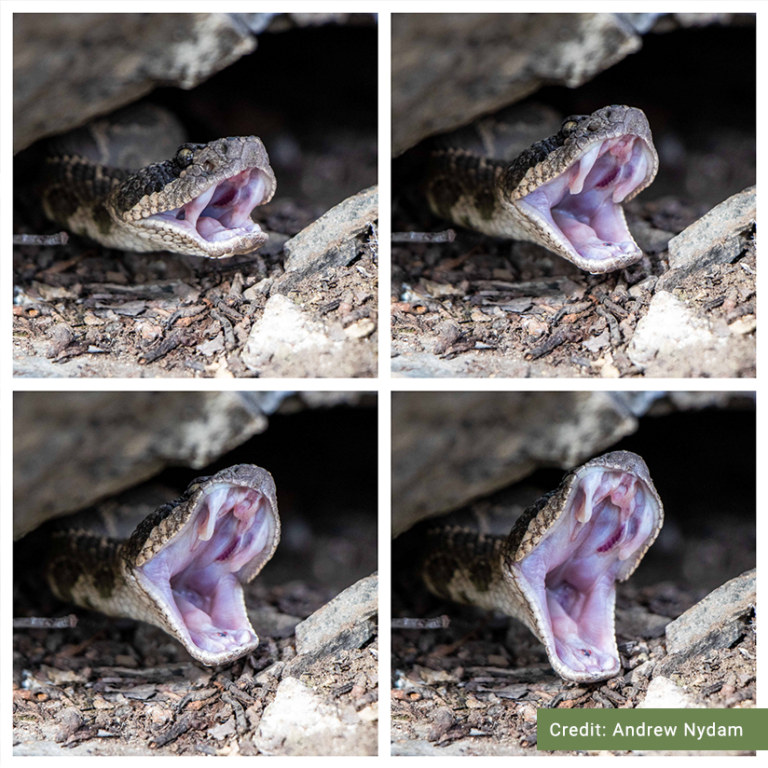
Adult Western Rattlesnake Yawning
What should I do if I spot a snake in my garden?
While it may seem scary for some to have a snake in their garden, it can actually be quite beneficial! Snakes like to eat pests such as mice, slugs, and insects, that may be eating or causing destruction to your garden. Therefore, snakes can act as natural pest prevention! To make your yard more snake friendly, you can keep some areas “wild” with longer grass and some rocks for shelter. This will provide snakes with shade to avoid overheating. Be sure to not use any pesticides or chemical fertilizers in your garden as these can be harmful to snakes and other wildlife. Additionally, be careful when moving rocks or wood, as there may be snakes or other wildlife using them for shelter.
If you think you have a rattlesnake in your garden, it is probably best to have it moved to avoid injury. Call the conservation officer service (1-877-952-7277) to get assistance.
If you think you have a rattlesnake in your garden, it is probably best to have it moved to avoid injury. Call the conservation officer service (1-877-952-7277) to get assistance.
For more information:
https://cwf-fcf.org/en/about-cwf/faq/faqs/what-should-i-do-if-i-spot-a.html
https://cwf-fcf.org/en/about-cwf/faq/faqs/what-should-i-do-if-i-spot-a.html
